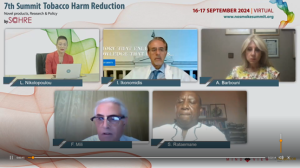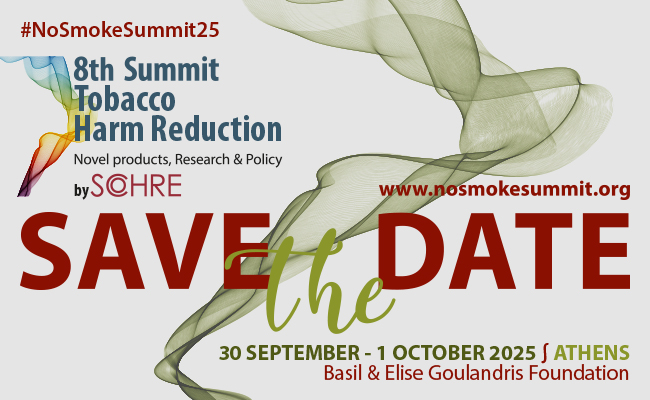Tobacco Harm Reduction should become a mainstream strategy for public health protection. This is the main message of the 7th Summit on Tobacco Harm Reduction: Novel products, Research & Policy, and one of the 10 proposals by SCOHRE—the International Association on Smoking Control & Harm Reduction—announced during the last session of the two-day virtual Summit that concluded on Sept. 17th.
View the Press Release in Greek | Κατεβάστε το ΔΤ στα ελληνικά.
The WHO claims that its strategy to address the tobacco epidemic is making progress, as measured by the number of people covered by its smoking control measures—more than 5.3 billion people, or 69% of the world’s population, are protected by at least one WHO measure. However, the number of smokers (1.3 billion globally) and the annual deaths from smoking-related diseases (8 million) are not considered key metrics. Additionally, the WHO is now targeting electronic nicotine delivery systems (ENDS), dismissing growing evidence that these products carry lower risks compared to conventional cigarettes.
SCOHRE aims to establish a unified, strong position that advocates for the WHO to adopt a more pragmatic approach, one that is based on emerging scientific evidence. The 7th Scientific Summit brought together experts and participants from 39 countries around the world* to discuss this expanding body of research, share experiences, and present best practices for modern, comprehensive, and more effective public health strategies that also take into account consumer preferences and their right to make informed decisions.
In the opening session of the Summit titled “Trends in THR Regulation – How the Future Looks Like”, chaired by the President of SCOHRE, Professor Ignatios Ikonomidis, Marewa Glover and Louise Ross reaffirmed the value of THR by presenting the evidence generated in UK and New Zealand. Following many years of the “Swap to Stop” strategy in the UK, Louise Ross emphasized that still “vaping holds a great promise” and highlighted its role in harm reduction and its impact on financial and mental health issues. She shared insights on the appeal of vaping as a smoking cessation method and the significance of understanding the pleasure principle associated with smoking. She also addressed the affordability and regulation of vapes, emphasizing the role of approved shops in ensuring product safety. She acknowledged that one of the biggest challenges that services in England face is the misleading information about vaping.
The success story of New Zealand that showed rapid decline in smoking after the regulation of vaping in 2019-2020, is not only that in 2022-23 smoking has dropped to 6.8%, but also that smoking prevalence declined both in European and indigenous Maori population, Marewa Glover said. Now New Zealand’s government will introduce stringent vaping regulations, including measures to prevent youth uptake and the potential implications of proposed bans on certain vaping products, such as heightened fines for selling to minors, etc. They also consider banning disposables and strengthening regulations around the packaging and names of e-liquids, which could impact popular vapes used by adults.
Dr Solomon Rataemane, a renown psychiatrist from South Africa, and one of the founding members of SCOHRE, delivered a keynote speech on the principles and techniques of Cognitive Behavioural Therapy (CBT) as a method for smoking cessation, emphasizing the importance of understanding triggers, coping mechanisms, and relapse prevention.
Dr. Konstantinos Farsalinos, a prominent advocate for flavours in Tobacco Harm Reduction (THR), particularly in vaping products, in his keynote speech focussed on flavoured vaping products and their alleged influence on youth vaping. He challenged the narrative of a “vaping epidemic” and the idea that flavoured products serve as a gateway to smoking among adolescents, demonstrating no significant correlation between flavoured vaping and increased smoking rates among middle and high school students. He advocated for regulatory measures that prioritize the protection of both youth and adult smokers, suggesting that control over packaging and labelling would be more effective than restricting flavour availability. “Smokers need an alternative product that is appealing, that is attractive, which means that they like to use it.”
The panel discussion moderated by David Sweanor titled “Prohibition or Regulation – Where is the Public Health Frontier?” focused on the ongoing debate between prohibition and regulation in public health, particularly regarding tobacco control. Sweanor highlighted the historical ineffectiveness of prohibition and its adverse outcomes, setting the stage for experts from various countries to present the actual results of the bans on the low-risk alternatives to cigarettes and to share their perspectives about effective strategies for reducing smoking.
Dr Fernando Fernandez-Bueno from Spain introduced the country’s new tobacco control plan, advocating for science-based strategies and harm reduction. He said that in recent years Spain has lost the leadership in fight against smoking that the country had earned nearly two decades before with the approval of the ambitious anti-tobacco law. Now Spain has an opportunity with this new Tobacco Control Plan that must focus on three key pillars. Science, building on international experience and societal stories, and strengthening prevention and cessation strategies with harm reduction. Mrs Maria Papaioannoy, addressed the need for a fresh approach to tobacco control in Canada, advocating for inclusivity and innovation in regulations for safer nicotine products, and pointed out the challenges faced by advocates and the detrimental effects of existing laws on harm reduction efforts. Unfortunately, Mrs Papaioannoy said, North America’s current tobacco control model is based in the past. Policymakers are not looking in the future, and they want to stop innovation. She announced her goal to create a new act, the Safer Nicotine Act, and talked about the importance of collective action in achieving this goal. Tobacco control needs to change, she explained, needs to be more inclusive and embrace innovation. Dr Sudhanshu Patwardhan stressed the necessity of using scientific literature to guide policymaking and the importance of understanding consumer needs, especially in low and middle-income countries where tobacco use poses significant challenges. He said that the public health frontier needs to be where the consumers are. It is true that regulation and policymaking is hard work, and prohibition is seen as an easy way out due to lack of local expertise. Dr Eugeniu Cotelea, highlighted the difficulties and the obstacles encountered in advocating for tobacco harm reduction in Moldova due to restrictive laws and opposition from the medical community. He spoke about restrictive laws that limit the free speech of medical practitioners. Professor Sweanor said that the sad reality is that these bans on free speech are promoted globally and are incredibly protective of the cigarette industry. These laws are present even in countries like the United States. It is not allowed to promote a reduced risk product—even though that’s absolutely true—unless the FDA allows it; however, FDA’s process makes approval virtually impossible. The result is that some people in the United States are misinformed because they are not getting information.
In another Summit session, Jeannie Cameron, founder of JCIC International, a UK based strategic advocacy consultancy focusing on tobacco harm reduction, presented the therapeutic potential of nicotine for neurological conditions and highlighted its benefits in reducing the risk and slowing the onset of diseases like Parkinson’s and mild cognitive impairment. Smokers have up to a 70% reduced risk of developing Parkinson’s disease because of the nicotine, she said and stressed an interesting fact: there are 69 identified carcinogens in tobacco smoke, but nicotine is not among them. Muazu Elazeh, an award-winning journalist from Nigeria, addressed the media’s negative portrayal of harm reduction, and elaborated on the critical role of journalists to assure science driven information to the consumer and protection of the public from misinformation or lack of information. Jeffrey Zamora, an activist in tobacco harm reduction from Costa Rica and President of ARDT Iberoamerica, provided an insightful and informative overview of the current state of harm reduction alternatives to smoking in Iberoamerica. In Latin America, he said, almost 49 million people who smoke are being denied access to proven, effective harm reduction products legally, and close to 9 million people who currently use nicotine-vaping devices are forced to do so through illicit sources.
The use of Tobacco Harm Reduction (THR) products was explored from two key perspectives: behavioural and clinical, based on research in Greece. Konstantinos Kesanopoulos presented findings from the 2023 and 2013 Global Youth Tobacco Surveys (GYTS) in Greece, focusing on adolescents aged 13-15. His analysis reveals significant changes over the past decade in tobacco use, cessation attempts, exposure to secondhand smoke, and the impact of tobacco control measures. Kallirrhoe Kourea presented research that investigates the effects of various tobacco and nicotine products—heat-not-burn (HNB) devices, electronic cigarettes (e-cigarettes), and conventional cigarettes—on the endothelial glycocalyx, a vital protective layer lining blood vessels. The research revealed that electronic cigarettes had a neutral effect, while heat-not-burn products showed slight improvements in larger vessels. She emphasized the importance of ongoing epidemiological studies and biomarkers to understand the long-term effects of various tobacco products.
Professor Andrej Fal in his keynote speech focused on the economic implications of lifestyle choices and the importance of financial tools in promoting healthier behaviors. He highlighted the evolving risk factors for chronic diseases, transitioning from traditional issues like undernutrition to modern challenges such as tobacco use, physical inactivity, and poor diet. Fal emphasized the significant economic burden of non-communicable diseases (NCDs) on labor productivity and financial output, advocating for the need to address modifiable behavioral risk factors. He presented compelling data on the potential returns on investment from health prevention initiatives, illustrating how promoting healthy habits could lead to substantial financial savings and improved quality of life. His concept “less harm, less tax” is pivotal to drive away consumers from the most harmful behaviors.
In the session entitled “Policy Frameworks for Promoting Public Health” health literacy and health education came up first as key elements in protecting public health. Professor Sharifa Ezat Wan Puteh presented results from Malaysia that managed to greatly reduce smoking rates in the last years. Education, the establishment of an effective legal framework and law enforcement were the key success factors. Unfortunately, Malaysia has a high percentage of illegal cigarettes and Tobacco Harm Reduction is not yet well received although NRTs are available through prescription. Piotr Karniej highlighted the need to invest in health education as early as possible in school children. “We need many, many health educators,” he stressed. People need to be informed about the health hazards of smoking before they are addicted but they must also have other choices if they are not unable or unwilling to give up smoking.
 In the last session of the 7th Summit on THR by SCOHRE the board members of the Association reaffirmed SCOHRE’s vision and presented 10 proposals aimed at combating the smoking epidemic and its harmful effects. Read the proposals in brief below, or view the full text here.
In the last session of the 7th Summit on THR by SCOHRE the board members of the Association reaffirmed SCOHRE’s vision and presented 10 proposals aimed at combating the smoking epidemic and its harmful effects. Read the proposals in brief below, or view the full text here.
- Awareness and informed decisions: Individuals must be supported in identifying what matters to them, ensuring clear, comparable information is available to guide their decisions.
- Bioethics & human rights: Policies on nicotine products should prioritize consumer empowerment and place bioethics and human rights at the forefront.
- Health literacy: Educating health professionals, smokers, and the public is essential for effective tobacco control. Health professionals must proactively support smokers in quitting, while smokers need the tools and resources to succeed.
- Network & collaboration: Sharing experiences and best practices can lead to modern, effective public health strategies and a unified, science-based stance on smoking control.
- Prevention: Preventing smoking initiation and exposure through taxation, stricter purchasing regulations, advertising restrictions, health warnings, and community-based interventions to protect vulnerable groups, especially youth.
- Robust regulatory framework: Regulations should empower consumers to make informed decisions, treat nicotine products proportionally to their risk, and be regularly updated with new scientific evidence. Tax laws should reflect product risk, while protecting consumers from misinformation.
- Evidence-based policy & research: Evidence-based policies provide a solid foundation for prevention and treatment. Ongoing, unobstructed research should generate data to inform smoking control and Tobacco Harm Reduction efforts.
- Smoking cessation: Smoking cessation remains the most powerful and cost-effective intervention to prevent smoking-related diseases. Prioritizing cessation through systematic identification and treatment of smokers is critical.
- Differential taxation: A health-promoting fiscal policy should tax tobacco and nicotine products based on the principle “less harm, less tax”. Regularly updated toxicity evaluations will help restrict access to high-toxicity products, reducing consumption and health burdens.
- Tobacco Harm Reduction: THR, alongside prevention, cessation, and fiscal tools, should be a mainstream strategy for public health protection. Lower-risk alternatives like vaping devices, nicotine pouches, and heated tobacco can improve health outcomes for smokers who switch.
*Countries represented at the 7th Summit:
Albania, Austria, Belarus, Belgium, Bulgaria, Brazil, Canada, Costa Rica, Cyprus, Czech Republic, Estonia, Greece, Hungary, India, Italy, Kenya, Kuwait, Lithuania, Malaysia, Moldova, Montenegro, New Zealand, Niger, Nigeria, Pakistan, Philippines, Poland, Portugal, Romania, Russia, Serbia, South Africa, Spain, Sweden, Tunisia, Turkey, United Kingdom, U.S.A., Zimbabwe.

